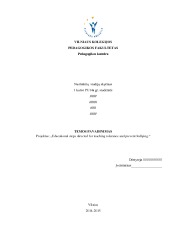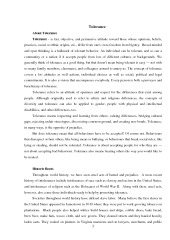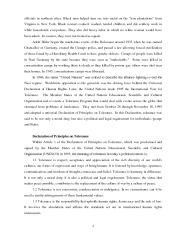Educational Steps Directed For Teaching Tolerance And Prevent Bullying



Tolerance About Tolerance. Declaration of Principles on Tolerance. Key Related Ideas. World of Difference. How to teach tolerance. How Tolerance Is Taught. Implementation of teaching tolerance in the curriculum. Mix It Up at Lunch Day program. The “ anti bias ” program. International Day for Tolerance. Some lessons ideas for teaching about tolerance. How tolerant are kids in your school? Words can hurt. Everybody Is Unique. How Can Parents Teach Tolerance. We can be more tolerant of people with different beliefs , by. Tolerating is not hard. Bullying About Bullying Bullying. The most important characteristics of bullying. Forms of bullying. How do children feel when they are being bullied. Why are people being bullied? Bullying in Lithuania. What is the VO? From bullying to suicide. How to prevent Bullying School officials and teachers cantake steps to prevent bullying. Develop a Zero Tolerance Policy. Educate Teachers on What to Look For. Foster a Positive Environment. Deal With Each Student on an Individual Basis. Deal With Bystanders Accordingly. Take Immediate Action. Don’t Ignore , Investigate. Some ideas for Anti Bullying Week.
Everybody Is Unique. Teach about how to respect for others unique qualities.
Sharing our beliefs with love, and being respectful listeners towards others with different beliefs;
Bullying - is deliberate, repetitive actions, which, in order to offend, hurt another person, causing psychological or physical force . Frequently bullying match a term - "harassment", but it is often perceived very narrowly - as sexual harassment.
While we are talking more about the characteristics of the phenomenon between children and teenagers, but it is typical not only for children and teens – bullying is often found in families and among adults at their workplaces.
Bullying is sometimes confused with a sense of humor - it is said that children are only joking, but the main difference from the joke is that bullying purpose is to hurt, humiliate another person.
This means that a child who is bullying, usually realizes that his or her actions hurt the other / s and they do it consciously.
Aggressive action that occurred once, is not bullying. We call that bullying behavior, that takes place systematically, for some time.
Thus, the child feels weaker than the perpetrators and can not defend himself from them. For example, the child is being hurt by a physically stronger child, or a child is attacked by several people. So it is very difficul for the child who is bullied to solve this problem, so it is necessary that other people would help him solve it.
Direct bullying - when a child is openly attacked, abused by his peers, for example : The child is pushed around, nicknamed, threatened him and etc.
Indirect bullying is called such behavior when the child is being bullied without direct aggression. This means rejection of the child from the group, ignoring him, inciting hatred against a child.
It is also possible to distinguish forms of bullying according to what aggression is used to hurt a child:
Rhetorical bullying - when a child is being verbally abused and inscriptions. This can be a persiflage, intimidation, joke remarks about the human body, religion, nationality, disability, appearance, "jokes", notes about the child, the child humiliating messages via mobile phones, e-mail messages, slander, libel.
Physical bullying – this is abuse of action: a kick or kicking, pushing, armbarring, spitting, breaking or taking away a childs objects, ripping clothing, hair plucking, nipping. This behavior is well known, which is often referred to jargon.
It is very painful when you are being bullied. Then you feel scared and unhappy. It can be so painful and embarrassing that interferes with concentration and learning. It makes you feel as if you were something bad, like something was wrong with you. Bullies try to make you feel like the most to blame for what is happening.
Children and adolescents who bully children usually have their own problems. They may feel sad or angry. Or maybe they do have problems at home?

















